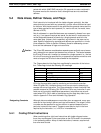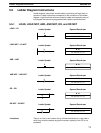
75
5-6 Bit Control Instructions
There are five instructions that can be used generally to control individual bit
status. These are OUT, OUT NOT, DIFU(13), DIFD(14), and KEEP(11).
These instructions are used to turn bits ON and OFF in different ways.
5-6-1 OUTPUT and OUTPUT NOT – OUT and OUT NOT
B: Bit
IR, HR, TR
Ladder Symbol Operand Data Areas
OUTPUT – OUT
B
B: Bit
IR, HR, TR
Ladder Symbol Operand Data Areas
OUTPUT NOT –
OUT NOT
B
Any output bit can be used in only one instruction that controls its status. See
3-3 Internal Relay (IR) Area
for details.
OUT and OUT NOT are used to control the status of the designated bit ac-
cording to the execution condition.
OUT turns ON the designated bit for a ON execution condition, and turns
OFF the designated bit for an OFF execution condition. OUT with a TR bit
appears at a branching point rather than at the end of an instruction line.
OUT NOT turns ON the designated bit for a OFF execution condition, and
turns OFF the designated bit for an ON execution condition.
OUT and OUT NOT can be used to control execution by turning ON and OFF
bits that are assigned to conditions on the ladder diagram, thus determining
execution conditions for other instructions. This is particularly helpful when a
complex set of conditions can be used to control the status of a single work
bit, and then that work bit can be used to control other instructions.
The length of time that a bit is ON or OFF can be controlled by combining the
OUT or OUT NOT with TIM. Refer to Examples under
5-11-1 TIMER – TIM
for details.
There are no flags affected by these instructions.
5-6-2 DIFFERENTIATE UP and DIFFERENTIATE DOWN –
DIFU(13) and DIFD(14)
B: Bit
IR, HR
Ladder Symbol Operand Data Areas
DIFU(13) B
B: Bit
IR, HR
Ladder Symbol Operand Data Areas
DIFD(14) B
Limitations
Description
Flags
Bit Control Instructions Section 5-6


















